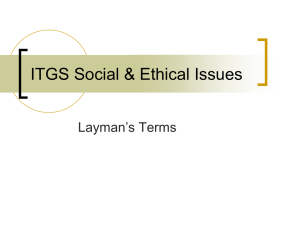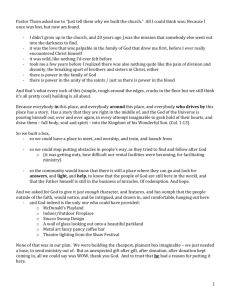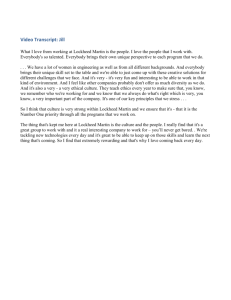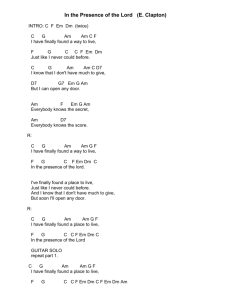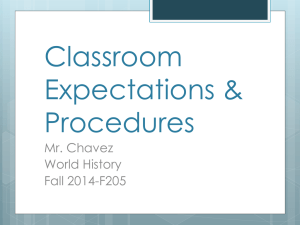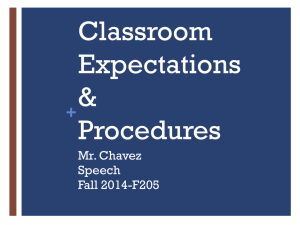moving-handling - Hertfordshire Grid for Learning
advertisement
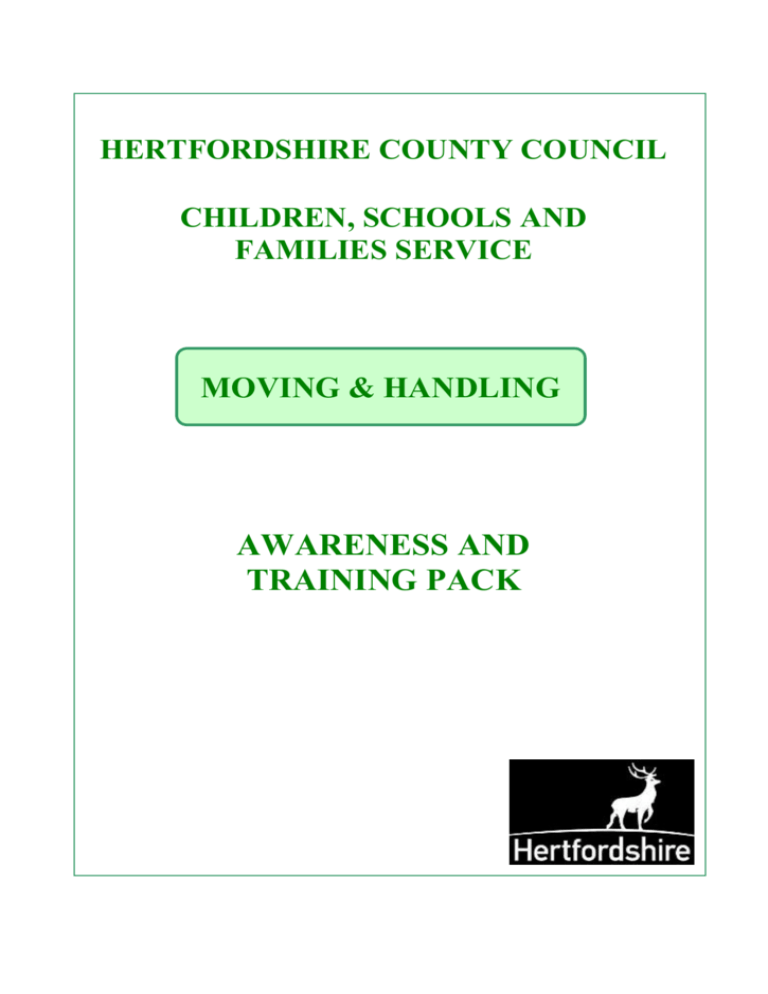
HERTFORDSHIRE COUNTY COUNCIL CHILDREN, SCHOOLS AND FAMILIES SERVICE MOVING & HANDLING AWARENESS AND TRAINING PACK MOVING & HANDLING Page 1 CONTENTS SECTION DESCRIPTION A General Information B The ‘Unhealthy’ Facts C The Legal Requirements D The Assessment E The Process F The Moving Guidelines G Moving Correctly H Questionnaire J Answers to Questionnaire Remember: Everybody, in any job, can be at risk. MOVING & HANDLING Page 2 SECTION A GENERAL INFORMATION This pack has been prepared to ensure that all staff are: 1. Aware of the problems which can arise from moving and handling at work, and 2. Given basic training on the correct method of moving and handling inanimate objects. The system is designed for you to work through at your own pace. Its important that you can put the content of this pack into practise – so that it becomes the rule rather than the exception. At the end of this pack you will be asked to complete an assessment questionnaire. Your Manager/Headteacher will than be able to check that you have understood the material. Your Manager/Headteacher will also want to see your moving and handling skills in action, and assist in helping you correct any faults in your technique. Remember: Everybody, in any job, can be at risk. MOVING & HANDLING Page 3 SECTION B THE ‘UNHEALTHY’ FACTS Why should you learn the RIGHT WAY to move and handle things? Because it will help reduce the risk of accidents and injury, to you and others around you. In 1992/93 50,000 manual handling injuries were reported to the Health and Safety Executive, resulting in some 3,600,000 lost working days. Over 34% of all injuries are due to moving, handling or load carrying. And what could an injury mean to you? Pain and suffering, perhaps for the rest of your life Loss of earnings Loss of your job Adverse effects on your family What are the main types of injury Strains and sprains – especially to the back Muscles and joints can be injured by over – exertion or moving incorrectly. Fractures Dropping heavy objects can break bones. Wounds Incorrect handling of sharp or rough objects can cut or bruise the skin. Hernias Ruptures in the abdominal wall can be caused by the strain of moving Remember: Everybody, in any job, can be at risk. MOVING & HANDLING Page 4 SECTION B LOOK AFTER YOUR BACK It is the only one you’ve got! Remember: Everybody, in any job, can be at risk. MOVING & HANDLING Page 5 SECTION B MAIN CAUSES OF ACCIDENTS & INJURIES Carelessness and bad habits Breaking the rules Not knowing the rules Faulty equipment Not thinking safety all the time Thinking it can’t happen to me Remember: Everybody, in any job, can be at risk. MOVING & HANDLING Page 6 SECTION C THE LEGAL REQUIREMENTS Under the Health and Safety at Work Act 1974 the County Council has a general duty of care to its employees. The Manual Handling Operations Regulations 1992 state more specifically the employer’s responsibilities toward moving and handling. These regulations establish a clear hierarchy of measures. 1. Hazardous moving and handling should be avoided so far as is reasonably practicable. 2. For any hazardous moving and handling that cannot be avoided a suitable and sufficient assessment should be made. 3. The risk of injury should be reduced, so far as is reasonably practicable. This includes the provision of effective training for employees. Employees Duties – Moving and Handling To take reasonable care of themselves while at work. To take reasonable care of others who may be affected by their acts and omissions. To follow established safe methods of working. To use safety equipment and/or protective clothing provided. To undertake and participate in appropriate Health and Safety training. To use the accident and hazard reporting procedures. Remember: Everybody, in any job, can be at risk. MOVING & HANDLING Page 7 SECTION D THE ASSESSMENT If a moving and handling task from which there is a significant risk of injury cannot be avoided or eliminated, then a suitable and sufficient assessment should be undertaken. The assessment should take into account (1) The load (2) The task (3) The working environment, and (4) The individual carrying out the task The Load – What has to be moved / handled? How heavy is it? Is it bulky / unwieldy? Is it difficult to grip? Is it unstable / predictable? Is it likely to be harmful e.g. sharp or hot? Is personal protective equipment required? The Task – What is to be done? Does the task involve: Twisting? Stooping? Reaching upwards? Holding away from the body? Carrying long distances? Pushing or pulling? Repetition? Strenuous work rate? Remember: Everybody, in any job, can be at risk. MOVING & HANDLING Page 8 SECTION D The Working Environment – Where / When is the work to be carried out? Are there: Constraints on posture? Tripping hazards on the route? Stairs or variations in floor levels? Hot / Cold conditions? Resting places? Inadequate lighting? Is there: The Individual – Who is to carry out the task? Will the work be carried out by male / female employees? N.B. – Guidelines weights for moving and lowering are 33% less for women than for men, see Section F, the Moving Guidelines. Does the task require: Unusual capabilities? Special information / training Will the task be a hazard for those: With health problems? Who are pregnant? Remember: Everybody, in any job, can be at risk. MOVING & HANDLING Page 9 SECTION E THE PROCESS So what do you do when you are asked (or need) to move / move something? Must you have an assessment carried out for everything? The answer to both questions is to take a common-sense approach. But the question you must ask yourself is – Is there likely to be a significant risk of injury? Now in many cases the answer will be No. So you go ahead and do it – or do you? Is there anything you should think about before you do any moving and handling? Take a second to: LOOK PLAN CONSIDER ASK Remember: Everybody, in any job, can be at risk. MOVING & HANDLING Page 10 SECTION E LOOK – WHAT SHOULD YOU BE LOOKING FOR? Examine the object carefully, are there any sharp edges or corners? Are there any signs, labels or markings on the outside of the packaging that you should read? Particularly regarding weight, contents or which way up the package should be. The Moving Guidelines, Section F, should be checked. Check to see if there are any broken or torn parts of the object that you are moving. Also check whether you can get a good grip on the object, is it wet or slippery in some way? A moments observation can save a lot of later discomfort. PLAN – THINK THROUGH YOUR MOVEMENTS AND YOUR ROUTE. Having first observed the object you are going to move or handle, the next stage is to think through the movements you are going to use and the route you are going to take. Think of the actual mechanics of the moving or the handling itself. The type of things you may want to check are: 1) 2) 3) 4) how you are going to stand is the floor space clear where you need to access a high area are there things in your way can you see clearly where you are going? Other things which, whilst common-sense, are essential before simply rushing in to move and move anything. CONSIDER – WHAT ELSE COULD MAKE THE TASK SAFER? It is important that you consider ways of actually helping yourself when manual handling or moving. Should you consider getting help, either by using an aid such as a trolley, barrow or hoist, or by asking someone to physically helps you. Is there any appropriate protective equipment that would make the operation safer? This might be gloves, shoes, protective clothing or may be protective glasses. Perhaps think all the types of protective and moving equipment that is available to use in your work place, and also if you have been trained to use it properly. Remember: Everybody, in any job, can be at risk. MOVING & HANDLING Page 11 SECTION E ASK – IF YOU ARE NOT SURE OR NEED ADVICE Asking for advice or assistance is actually a sign of strength not weakness. If you are not sure about something or need advice, you must ask. Not only is this commonsense, it is also a legal obligation under the regulations, that if you are unsure about your capabilities or about techniques of handling or moving any item, you have a responsibility to ask or question your Manager/Headteacher about this. Ask if there are any handling aids or protective equipment available, and if you are not sure about their use, or have not been trained to use them - Ask. So by Looking, Planning, Considering and Asking; you have actually carried out an assessment. To you that assessment us suitable and sufficient and that is all that needs to be done. This will be all that is needed to move / handle say a box of paper, a small chair or a desk drawer. Moving Correctly, Section G, would be the next step. But if the desk drawer contained a number of heavy files, or you were to move a computer processor which was linked to a keyboard, printer and screen then you would need to breakdown the task i.e. take out some (or all) of the files or disconnect the units of the computer, before being able to undertake the moving and handling in a safe way. Again you have carried out an assessment and if there is still no risk of significant injury, you need to go no further with the assessment process. Again, Moving Correctly would be the next step. However, if you or your Manager/Headteacher think there is the possibility of a significant risk of injury then a written assessment should be completed before the work is undertaken. If the work is regularly undertaken, there may be no need to carry out an assessment on every occasion. But although the load and the task may be similar, the working environment and/or the individual may change, a check may be required to ensure that all conditions of the assessment are still valid. Remember: Everybody, in any job, can be at risk. MOVING & HANDLING Page 12 SECTION E THE ASSESSMENT FORM (Please photocopy freely) Do not be put off by having to fill in, or help fill in, the form. It is there to help safeguard you and your colleagues. Although its quick and easy to fill in, make sure you check or read carefully, take notice of any issues raised or remedial actions and think of high risk activities. The completion of an assessment form on its own will not reduce accidents and injuries – only you can do that. Remember: Everybody, in any job, can be at risk. MOVING & HANDLING Page 13 SECTION E High Risk Activities Repetitive or restricted movements Moving awkward or heavy loads Working in an awkward posture Frequent bending Forceful, repetitive or rapid moves Traditional methods of moving Remember: Everybody, in any job, can be at risk. CHILDREN, SCHOOLS AND FAMILIES SERVICE Page 14 MOVING AND HANDLING ASSESSMENT Location: ……………………………………………………………………………………… Date of Assessment: ………………………. By: ……………………………………………. SECTION A – OUTLINE ASSESSMENT Description of ‘the load’, including numbers etc …………………………………………………… ……………………………………………………………………………………………………….. Dimension: …………………………………………………………………………………………… Weight: ……………………………………………………………………………………………….. Can manual moving/handling be avoided at reasonable cost? YES/NO If YES please give details: …………………………………………………………………………… ………………………………………………………………………………………………………… Are mechanical aids available/applicable? YES/NO If YES please give details: …………………………………………………………………………… ………………………………………………………………………………………………………… How many staff are required to move/handle the load safely? ………………………………… Have staff been instructed on how to move/handle loads safely? YES/NO NB: Staff should not be asked to move/handle until instruction has been given. Are the route and work environment free from hazard? YES/NO If NO please give details: …………………………………………………………………………….. ………………………………………………………………………………………………………… Is Personal Protective Equipment required to undertake the task? YES/NO If YES please give details: …………………………………………………………………………… ………………………………………………………………………………………………………… Using the information given above, is there a significant risk of injury? If YES, all other sections of this form should be completed. NB: This assessment should be shown to the staff before work begins. All moving and handling should only go ahead under reasonable supervision. Remember: Everybody, in any job, can be at risk. YES/NO SECTION B – DETAILED ASSESSMENT Page 15 Questions to consider (If the answer to a question is ‘Yes’ place a tick against it and then consider the level of risk) Yes Level of risk: (Tick as appropriate) Low Med Comments (including remedial action to be taken) High The tasks – do they involve: Holding loads away from trunk? Twisting? Stooping? Reaching upwards? Large vertical movement? Long carrying distances? Strenuous pushing or pulling? Unpredictable movement of loads? Repetitive handling? Insufficient rest or recovery? A workrate imposed by a process? The loads – are they: Heavy? Bulky/unwieldy? Difficult to grasp? Unstable/unpredictable? Intrinsically harmful? The working environment – are there: Constraints on posture? Poor floors? Variations in levels? Hot/cold/humid conditions? Strong air movements? Poor lighting conditions? Individual capability – does the job: Require unusual capability? Hazard those with a health problem? Hazard those who are pregnant? Call for special information/training? Other factors Is movement or posture hindered by clothing or personal protective equipment? SECTION C – OVERALL ASSESSMENT OF RISK After taking the remedial action, as specified, what is the overall assessment of risk of injury? LOW/MEDIUM/HIGH What additional action is required to further reduce the risk of injury? Remember: Everybody, in any job, can be at risk. MOVING & HANDLING Page 16 SECTION F THE MOVING GUIDELINES Guidelines for Moving and Lowering Basic guideline figures for manual handling operations involving moving and lowering are set out below. They assume that the load is readily grasped with both hands and that the operation takes place in reasonable working conditions with the handler in a stable body position. The guideline figures take into consideration the vertical and horizontal position of the hands as they move the load during the handling operation, as well as the height and reach of the individual handler. It will be apparent that the capability to move or lower is reduced significantly if, for example, the load is held at arm’s length or the hands pass above shoulder height. If the hands enter more than one of the box zones during the operation the smallest weight figure should be used. The transition from one box to another is not abrupt; and intermediate figure may be chosen where the hands are close to a boundary Remember: Everybody, in any job, can be at risk. MOVING & HANDLING Page 17 SECTION G MOVING CORRECTLY So now you are ready to move/handle the load. What should you do? THE TECHNIQUE OF MOVING Where moving or lowering with the hands beyond the box zones is unavoidable a more detailed assessment should be made. Remember: Everybody, in any job, can be at risk. MOVING & HANDLING Page 18 SECTION G To ensure you can undertake the task correctly ad safely these are the Six Steps for Safe Moving. Position Bend Get a good grip Move with your legs Look ahead Hold the load close These six steps will ensure that you move things not only correctly but also in a way that is safe as possible and minimises the risk of injury to yourself and others. Remember: Everybody, in any job, can be at risk. MOVING & HANDLING Page 19 SECTION G Step 1: Position Consider what you are moving Consider the best position Stand correctly Test before moving PAUSE AND TAKE ACTION The very first step, regardless of what you are moving or how heavy it is, is to take a few seconds to think carefully about how we are going to move it, the route you are taking when you are carrying it, where you are actually going to put it and, most importantly perhaps, how to position yourself correctly over, around or next to the object. Many injuries and discomfort are caused by an incorrect position that puts undue strain on the muscles or the back. The position of your feet are particularly important and they should be placed around, normal width apart, say about 18”, either side of the object so you have a good solid stance. You should also be as close to the object as possible. If there are things that need to be moved or adjusted or moving aids that you need to go and get, then do this before beginning the operation. For instance, all of us will occasionally kick the door open whilst carrying objects, which is increasing the risk of an accident or injury happening. What you should do is to open, or prop the door open, before beginning our move. Now that you have undertaken this instruction performing this kind of action could be deemed as unsafe working practice. This means that if you did do this, and were involved in an accident or injury, the liability could be yours because you now know better! 1 Remember: Everybody, in any job, can be at risk. MOVING & HANDLING Page 20 SECTION G Step 2: Bend Get “underneath” the load Bend with the knees Keep your back straight Don’t stoop or stretch BEND Part of positioning is to make sure you get “underneath” the load. This means that you actually bend your knees and get a grip, that is actually holding the load or the object, as much as you can underneath the main centre of gravity. Safe moving means moving with your legs, not your back. Bend your knees, keep your back straight and lower yourself down to the same level as the object you want to move. Then, when you do move, you will be able to push up with your legs, keeping your back straight all the time. 2 Remember: Everybody, in any job, can be at risk. MOVING & HANDLING Page 21 SECTION G Step 3: Grip Hands underneath corners, avoiding sharp edges or anything loose Test your grip before fully moving Get Right In Position GRIP If you are moving a box or a reasonably square object, as is common, your hands should be underneath the corners avoiding any sharp edges or any loose materials, and have a firm secure grip. Before moving, or taking the main weight, test your grip fully. Use your grip to lean the weight into your body making sure that its centre of gravity, or the heaviest part of the load, is closest to you. If you need to wear protective gloves, either to get a better grip or to protect your hands, it is essential that you do this. You may also need to consider if you are wearing the correct footing. This is to get a grip on the surface you are working on, and also to protect your feet in the event of a dropped load. 3 Remember: Everybody, in any job, can be at risk. MOVING & HANDLING Page 22 SECTION G Step 4: Look Keep looking all around as you move or carry Keep your head erect and your back straight You steer with your eyes, so look where you are going all the time LOOK UP When you are actually moving, carrying or moving an object, it is important that you keep looking all around you as you do so. Not only do you need to look where you are going and make sure that you do not walk into something, or someone bumps into you, but also, and perhaps most importantly, it ensures that you move correctly. Keep your head erect, upright and your back straight. If you begin to drop your head then this in turn may cause your back to bend or curve, putting undue strain on the ligaments and muscles of the lower back in particular. So it is important that you keep your head up and your shoulder back. You also steer with your eyes, so that you look where you are going all the time; not at the floor or where you have been, but straight ahead – in the direction that you are moving, and where you are putting your feet. 4 Remember: Everybody, in any job, can be at risk. MOVING & HANDLING Page 23 SECTION G Step 5: Move with your legs Your legs are the largest muscle group in the body – use them to protect your back – which is the most complex and fragile Bend your knees and push up 1. Squat, rather than stoop, to grasp the load 2. Straighten the back so that it is in the line of gravity. Then let the leg muscles do the moving The wrong way to move! MOVE WITH YOUR LEGS Your legs are the largest muscle group in the body; you only have to look at any weight lifter or power sports athlete to see that is true. When a weight lifter or bodybuilder becomes skilled at moving very heavy weights, it is usually their legs that become the biggest or the strongest. In contrast, the back muscles, and the back structure in particular, are extremely complex and extremely fragile. You can damage your back very easily and with the smallest load. When you take the weight of an object you must do so with your legs. If you are moving an object from the floor, rather than bending over and moving with the arms, it is much safer bend your knees crouched down over the object, get a secure grip and then move up straightening our knees and pushing up as you do so. When moving or carrying items make sure that the weight is resting with your legs and not on your back. 5 Remember: Everybody, in any job, can be at risk. MOVING & HANDLING Page 24 SECTION G Step 6: Hold the load close The closer the load to the body, the less strain on your back HOLD THE LOAD CLOSE This step is particularly simple and almost deceptively obvious, but is vitally important to remember. The closer you hold the load or the object to yourself the less strain that you put on your back. Always make sure you have the heaviest part of whatever your moving towards you and pull it as close to you as possible. Often, people report strains and injuries when trying to move items but do not want them to touch their clothing for some reason. For instance, when unloading gardening materials from the boot of out car, we will deliberately hold them away from us, in doing so risk very painful or disabling injuries as a result. 6 Remember: Everybody, in any job, can be at risk. MOVING & HANDLING Page 25 SECTION G MOVING CORRECTLY So let’s go through the six steps once more. Remember: Everybody, in any job, can be at risk. MOVING & HANDLING Page 26 SECTION G Step 1: Position Consider what you are moving Consider the best position Stand correctly Test before moving 1 Remember: Everybody, in any job, can be at risk. MOVING & HANDLING Page 27 SECTION G Step 2: Bend Get “underneath” the load Bend with the knees Keep your back straight Don’t stoop or stretch 2 Remember: Everybody, in any job, can be at risk. MOVING & HANDLING Page 28 SECTION G Step 3: Grip Hands underneath corners, avoiding sharp edges or anything loose Test your grip before fully moving Get Right In Position 3 Remember: Everybody, in any job, can be at risk. MOVING & HANDLING Page 29 SECTION G Step 4: Look Keep looking all around as you move or carry Keep your head erect and your back straight You steer with your eyes, so look where you are going all the time 4 Remember: Everybody, in any job, can be at risk. MOVING & HANDLING Page 30 SECTION G Step 5: Move with your legs Your legs are the largest muscle group in the body – use them to protect your back – which is the most complex and fragile Bend your knees and push up Test the weight before moving 5 Remember: Everybody, in any job, can be at risk. MOVING & HANDLING Page 31 SECTION G Step 6: Hold the load close The closer the load to the body, the less strain on your back 6 Remember: Everybody, in any job, can be at risk. MOVING & HANDLING Page 32 SECTION G Moving Check – List Here is a list of points which may help you. Hold the load as close to the body as possible Don’t twist, stretch or stoop Don’t reach or stretch upwards – use steps Avoid excessive or repeated movements Don’t carry things long distances Don’t push or drag very heavy objects Move unbalanced objects carefully Take regular breaks when doing repetitive tasks Remember: Everybody, in any job, can be at risk. MOVING & HANDLING Page 33 SECTION G Top Ten Moving Errors 1. HOLDING THE LOAD AWAY FROM THE TRUNK 2. TWISTING 3. STOOPING 4. REACHING UPWARDS 5. EXCESSIVE UP AND DOWN MOVEMENTS 6. CARRYING LONG DISTANCES 7. STRENUOUS PUSHING OR PULLING 8. UNPREDICTABLE OR UNBALANCED LOADS 9. REPETITIVE HANDLING AND MOVING 10. WORK-RATE TOO STRENUOUS Remember: Everybody, in any job, can be at risk. MOVING & HANDLING Page 34 SECTION H QUESTIONNAIRE So to recap these are the major issues covered in this package. The ‘Unhealthy’ Facts The Legal Requirements The Assessment The Process The Moving Guidelines Moving Correctly You now have all the information to enable you to go ahead and move correctly, and safely. However to conclude your training you are asked to complete the assessment questionnaire. This is to check that you have understood the moving and handling information you have read. Try and answer the questionnaire without reference to the package, although all answers are available from within the text. Remember: Everybody, in any job, can be at risk. MOVING & HANDLING Page 35 SECTION H Questionnaire Name …………………… Q1 What percentage of all injuries are due to moving, handling or load carrying? ……………… Q2 List 3 possible categories of injuries that might occur, or be caused by incorrect or improper moving. i ………………………………………………………………………... ii ……………………………………………………………………….. iii ………………………………………………………………………. Q3 Give 2 causes of accidents and injuries at work. i ………………………………………………………………………... ii ……………………………………………………………………….. Q4 What Regulations state the employers’ responsibilities toward moving and handling? ………………………………………………………………………… Q5 List 3 duties or employees in relation to moving and handling at work i ……………………………………………………………………….. ii ………………………………………………………………………. iii ……………………………………………………………………… Q6 In carrying out an assessment what are the four main things to be taken into account? i ………………………………………………………………………... ii ……………………………………………………………………….. iii ………………………………………………………………………. iv ………………………………………………………………………. Q7 Before you undertake any moving and handling what four points should you think about? i ………………………………………………………………………... ii ……………………………………………………………………….. iii ………………………………………………………………………. iv ………………………………………………………………………. Remember: Everybody, in any job, can be at risk. MOVING & HANDLING Page 36 SECTION H Q8 Does a good position for moving/handling include Moving from the knees? Keeping the feet together? Keeping the back straight? Keeping the arms straight? Leaning over the load? Looking ahead and up? Q9 YES/NO YES/NO YES/NO YES/NO YES/NO YES/NO What does G R I P stand for? G …………………………... R …………………………… I ……………………………. P …………………………… Q10 Which is the largest muscle group in your body – your legs or your back? …………………………………………………………………………….. Q11 Should you carry a close to your body, or at arms length from you? ……………………………………………………………………… Remember: Everybody, in any job, can be at risk. MOVING & HANDLING Page 37 SECTION J NOTE TO MANAGERS/HEADTEACHERS The preferred option is for you to work through this pack with your staff, either in groups or individually. Staff should then complete the questionnaire. The answers are published separately for you to discuss them with the staff concerned, clarifying any points as necessary. Remember: Everybody, in any job, can be at risk. MOVING & HANDLING Page 38 SECTION J Answers to Questionnaire Q1 Over 34% Q2 3 from Strains and sprains Fractures Wounds Hernias Q3 2 from Carelessness and bad habits Breaking the rules Not knowing the rules Faulty equipment Not thinking safety at all times Thinking it can’t happen to me/us Q4 Manual Handling Operations Regulations 1992 Q5 3 from Taking reasonable care of others who may be affected by their acts and omissions Taking reasonable care of others who may be affected by their acts and omissions Following established safe methods of work Using safety equipment and/or protective clothing provided Undertaking and participating in appropriate Health and Safety training Using accident and hazard reporting procedures Remember: Everybody, in any job, can be at risk. MOVING & HANDLING Page 39 SECTION J Q6 The Load Task Working environment Individual carrying out the task Q7 i. ii. iii. iv. Look Plan Consider Ask Q8 i. ii. iii. iv. v. vi YES NO YES NO YES YES Q9 Get Right In Position Q10 Your legs Q11 Close to your body Remember: Everybody, in any job, can be at risk.


